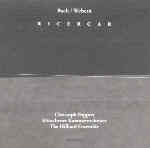What a dumb “concept” album! The placement of the Bach/Webern Ricercar from the Musical Offering at the beginning and end of this disc presupposes that you will want to listen to its entire 69 minutes at a single sitting. Despite generally fine performance standards, this represents an alarmingly dreary prospect (and I know because I did it). It further implies that there is some similarity between the two composers beyond the fact that both were German, both wrote cantatas (though you won’t find one of Webern’s here), and Webern admired Bach (what subsequent composer didn’t?). Okay, Webern admired Bach enough to orchestrate that Ricercar, but then Bach hasn’t lacked for enterprising arrangers, from Mozart to Mendelssohn, Villa Lobos, Schoenberg, Mahler, Elgar, Stokowski, and Respighi (to name only a few), and none of them appear here. Apparently it has to be Webern, and only Webern, and only Webern’s string quartet/string orchestra works at that–the crème de la crème of Webernian austerity.
Unfortunately, mixing Webern with Mozart, Schubert, Schumann, and other “echt Deutsch” composers seems to be a German cultural tick, kind of like the French fondness for Jerry Lewis movies. But a concept imposed on music independent of its actual sound or style is just plain nonsense. And yes, Webern’s style does resemble Bach’s to this wholly generic extent: both employed all 12 notes of our chromatic scale with some regularity, and both liked counterpoint. Big deal. Play any piece by Bach next to any piece by Webern (yes, even Bach’s Chromatic Fantasy and Fugue) and tell a music-loving but otherwise innocent friend that the two have a deep and abiding kinship, and observe the reaction. Then backpedal a bit and insist that the point of this repellent juxtaposition actually lies in the dissimilarities as much as the similarities. “So why should I buy a disc of pieces that don’t belong together just to confirm that fact?” I hear your friend exclaim. “Isn’t that a big waste of time and money?”
And so it proves. The combination of Bach’s Christ lag in Todesbanden with Webern’s Five Movements for String Quartet (in the string orchestra version) has about as much appeal as chocolate sauce on liver–and I say this as an admirer of both Bach and Webern. The early String Quartet gains nothing by having its already dense harmonic texture tarted up in conductor Christoph Poppen’s version for string orchestra, however well played. Still, any observer has to admit that the performance of the Cantata is very good: lively, sympathetic, and affectingly sung (as might be expected) by members of the Hilliard Ensemble. But what is it doing in these surroundings? And what musical point is there to listening to that 6-part Ricercar twice?
I’m not going to speculate as to who will find this tedious exercise in artistic navel-gazing appealing. Let’s just say that anyone who likes Bach interwoven with Webern long ago figured out how to use their multi-disc CD changer, CD burner, or cassette player in order to indulge their whim. And don’t even think of making sense of the booklet notes: they are positively the last word in pretentious twaddle. The rating reflects the “concept” as much the performances themselves, which as noted above, are actually quite good. ECM graces the program with a title: Ricercar, but in keeping with its last (equally suspect aesthetically, if admittedly popular) effort in this direction, it strikes me that “Bore-imur” would have been more appropriate.
































